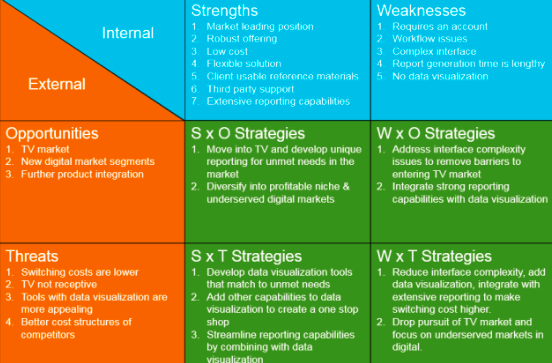
SWOT is a tried and true method for getting a better understanding of a company, but chances are that you’re doing it all wrong. In my previous article, we discussed the importance of having reliable, accurate information as the basis for conducting an effective SWOT analysis. In this article, I will walk you through a framework for conducting a thorough, effective SWOT analysis that yields insights you can act upon.
As a reminder, SWOT is a way of analyzing a company by researching and understanding their strengths and weaknesses. You then compare their Strengths and Weaknesses to Opportunities and Threats in the marketplace to assess the company’s internal capabilities with external possibilities.
Performing a SWOT
Now that we understand the importance of using reliable data to perform a SWOT analysis, how do we go beyond the basic assessment of strengths, weaknesses, opportunities, and threats? To begin with, you must approach the assessment of each element with the correct perspective. In assessing strengths and weaknesses you should be asking:
Strengths: What can the company do well? What can they do better than their marketplace peers? What resources do they have that others do not? What resources do they have that are superior to their marketplace peers?
Weaknesses: What does the company do poorly? What are their limitations, faults, and defects? What do the competitor’s marketplace peers do much better than the competitor?
Ask these questions for each of the categories you gathered information on using the research framework we discussed in the previous article. Does the company have a strong/weaker business model than their peers? Does the company have stronger/weaker partnerships? Etc.
When you assess marketplace opportunities and threats you should be asking:
Opportunities: What favorable or advantageous situations exist in the market? These could be trends (social, technology, economic, environmental, and political), unaddressed customer needs, potential partnerships, attractive adjacent markets, new technologies, or anything else that could advance a company’s position in the market.
Threats: What situations are arising in the market that are unfavorable to the company? These could be negative trends, supply chain problems, or brand-damaging mistakes. Anything that creates problems, barriers, constraints or other impediments to the ability of the company to win in the market are considered a threat.
When researching the companies, you will invariably gather information about the market. But you may need to do some additional research on the market to get a complete view of the opportunities and threats. Again, frameworks are useful here too. I often use the STEEP framework to research the external business environment. STEEP stands for Societal, Technology, Economic, Environmental, and Political.
Going Beyond the Basic SWOT
So far, this pretty straightforward and is the standard definition of a SWOT analysis. To take this to the next level we need to begin crossing strengths and weaknesses with opportunities and threats to see what strategies and tactics a competitor could pursue. Not only will this help you understand what paths a competitor may take and plan for those possible scenarios, but you will undoubtedly find new opportunities your company may want to pursue.
Below is a real example to get an idea of how crossing strengths and weaknesses with opportunities and threats come together. This example is from the digital advertising industry. The analysis below in Figure 1 has been shortened up for brevity and to make it easier to illustrate the concept. Your analysis should have more detail.

The extra step of crossing strengths and weaknesses with opportunities and threats creates a new perspective on the competitor. In practice, you may end up with a long list of potential strategies that the competitor could pursue. To help make sense of the mosaic of potential strategies, scores can be assigned to each strategy, such as a 1 or a 0. A score of 1 represents a seemingly strong strategy between a strength/weakness or opportunity/threat while also being within the core capabilities of the competitor. A score of 0 represents a weak strategy and a challenge for the competitor to achieve. When the strategies are reviewed and vetted, what remains is the competitive advantage the competitor could pursue.
Taking the extra step of crossing strengths and weaknesses with opportunities and threats makes the results of the SWOT more actionable. Stopping at the typical quadrant chart doesn’t leave you with specific, actionable, situations that you can pursue or defend against. Go back and look at the digital advertising example. If you only had the four quadrants of SWOT and didn’t cross them to generate the possible strategies the competitor could take, would that analysis be as actionable? Seeing the possible strategies your competitors may take gives you concrete insights from which you can build your own competitive strategy. Looking at your competitors from this alternative perspective may also reveal strengths, weaknesses, opportunities, and threats about your own company that you didn’t realize you had. Now, the hard part – actually doing it.
This is where Big Village’s company assessments can help! Clients use our company assessments to review acquisition targets, evaluate potential partners, size up competitors, and assess new suppliers. Our company assessments give you a detailed look at a company. Download our one-sheet to learn more about how Big Village’s company assessments can help you today.
Big Village’s Accelerated Intelligence Service integrates human interaction and content with the efficiencies of technology to deliver cost-effective business decision support. Our team of analysts has access to thousands of authoritative published content sources to address your critical business decisions. Our analysts leverage continuously improving data sources that integrate text analytics, artificial intelligence, and other technologies. We have a scalable model that enables you to access a comprehensive set of key information sources that you can afford based on your actual needs.
We create holistic solutions by blending advisory expertise, insights from extensive authoritative published sources, professional insights from peer-recommended experts, rapid consumer surveys, and social media analytics. Contact us today to learn how Big Village can take your company assessments and SWOT analysis to the next level.
Written by Brian Reuter, Senior Vice President of Big Village’s Accelerated Intelligence Service and Expert Big Village.
